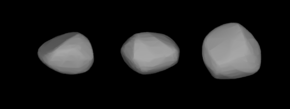 Three-dimensional model of 26 Proserpina created based on light-curve inversions. | |
| Discovery | |
|---|---|
| Discovered by | R. Luther |
| Discovery date | May 5, 1853 |
| Designations | |
| (26) Proserpina | |
| Pronunciation | /proʊˈsɜːrpɪnə/[1] |
Named after | Proserpina |
| 1935 KK; 1954 WD1 | |
| Main belt | |
| Adjectives | Proserpinian /ˌprɒsərˈpɪniən/[2] |
| Symbol | |
| Orbital characteristics | |
| Epoch June 14, 2006 (JD 2453900.5) | |
| Aphelion | 431.898 Gm (2.887 AU) |
| Perihelion | 362.816 Gm (2.425 AU) |
| 397.357 Gm (2.656 AU) | |
| Eccentricity | 0.087 |
| 1581.184 d (4.33 a) | |
| 115.619° | |
| Inclination | 3.562° |
| 45.884° | |
| 193.120° | |
| Physical characteristics | |
| Dimensions | 94.8 ± 1.7 km (IRAS)[3] 89.63 ± 3.55 km[4] |
| Mass | (7.48 ± 8.95) × 1017 kg[4] |
Mean density | 1.98 ± 2.38 g/cm3[4] |
| 13.11 h[3][5] | |
| 0.1966[3][6] | |
| S[3] | |
| 7.5[3] | |
26 Proserpina is a main-belt asteroid discovered by German astronomer R. Luther on May 5, 1853. It is named after the Roman goddess Proserpina, the daughter of Ceres and the Queen of the Underworld. Another main-belt asteroid, 399 Persephone, discovered in 1895, is named after her Greek counterpart. Its historical symbol was a star inside a pomegranate; it is in the pipeline for Unicode 17.0 as U+1CECD (![]() ).[7][8]
).[7][8]
This object is orbiting the Sun with a period of 4.33 years. It has a cross-section size of around 90 km and a stony (S-type) composition. Photometric observations of this asteroid have produced discrepant estimates of the rotation period. A period of 12.13 hours was reported in 1979, followed by 10.6 hours in 1981 and 6.67 hours in 2001. Observations made in 2007 at the Oakley Observatory in Terre Haute, Indiana produced a light curve with a period of 13.06 ± 0.03 hours and a brightness variation of 0.21 ± 0.01 in magnitude.[9] This was refined by a 2008 study, giving a period of 13.110 ± 0.001 hours.[10]
- ^ Noah Webster (1884) A Practical Dictionary of the English Language
- ^ E.g. Andrew & Reid (2003) Two Hundred Years of Pushkin
- ^ a b c d e Cite error: The named reference
jpldatawas invoked but never defined (see the help page). - ^ a b c Cite error: The named reference
Carry2012was invoked but never defined (see the help page). - ^ "Asteroid lightcurve derived data". Archived from the original on 13 September 2006. Retrieved 11 August 2006.
- ^ "Asteroid Albedos". Archived from the original on 22 July 2012. Retrieved 11 August 2006.
- ^ Bala, Gavin Jared; Miller, Kirk (18 September 2023). "Unicode request for historical asteroid symbols" (PDF). unicode.org. Unicode. Retrieved 26 September 2023.
- ^ Unicode. "Proposed New Characters: The Pipeline". unicode.org. The Unicode Consortium. Retrieved 6 November 2023.
- ^ Cite error: The named reference
DitteonHawkins2007was invoked but never defined (see the help page). - ^ Cite error: The named reference
Pilcher2008was invoked but never defined (see the help page).